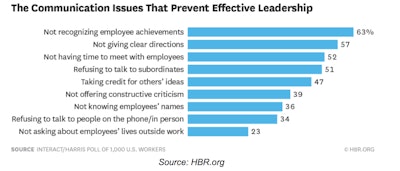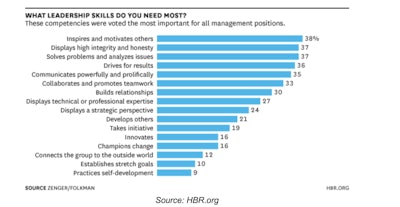
Good managers know how to balance workplace productivity against the needs of their workers, financial and productivity pressures, and regulatory agencies. This requires the ability to listen as well as prioritize work and make sound decisions.
At its core, management is little more than getting things done through others. If you want to make sure your management organization is efficient, you’ve first got to consider what it takes to be a good manager — leadership skills, communication skills and the ability to delegate tasks. Then you’ve got to figure out the best organizational structure so employees and managers are clear about who does what, can resolve workplace issues quickly, and get back to work.
In the construction industry, you have have the additional challenge of managing workers who are off site and sometimes in difficult conditions with safety hazards, unpredictable weather or complex tasks. You also have agencies, like the OSHA, looking over your shoulder.
Here are some tips to increase efficiency throughout your organization.
Promote the Right People
Don’t automatically assume your best worker will be your best manager. Promoting the wrong person is one of the biggest mistakes businesses make in labor management. Although it sounds counter-intuitive, the most skilled workers aren’t always the best equipped to manage others. Both technical and leadership skills are important, of course, but being the best at a given job doesn’t make someone the best boss. In fact, it often reduces your organizations’ efficiency.
By taking the most productive worker off the job and promoting them to manager, you’ve just lowered your team’s productivity. In addition, the best worker may also be a person who expects others to do things the same way they do. Or, they may have ‘best practices’ in their head but not the best communication skills. A skilled worker who is the best a doing their skilled job may not be best at leading others to do it.
Having technical job skills is important, of course, but it’s only one of the many factors that makes a good manager or leader. So before you consider promoting someone to management, ask yourself what makes a good manager?
Let’s take communication for an example. If you put someone in a leadership role who has poor communication skills, what happens? Employees become disengaged and may not be as likely to do great work. The chart below shows the kinds of communication issues that arise when a manager doesn’t have great communication skills.

So how do you improve performance by choosing managers with the right skills? The good news is that entire organizations are dedicated to determining the kinds of competencies or skills a good manager should have. With over 30 years of research data to support them, Lominger and Korn/Ferry have identified the following eight leadership competencies as the most important.
- Dealing with ambiguity — managers who can manage change, such as job specs, adapt quickly to get their team on track and work done in spite of changes
- Creativity — managers who can see more than one way to solve a problem and allow their workers to be creative as well
- Innovation management — managers who actively seek out new approaches to save money or improve effectiveness
- Strategic agility — managers with interpersonal skills that allow them to deal with customers, regulatory agencies, insurance company reps, and others who have influence on the work of their team
- Planning — managers who have the insight to prioritize some work ahead of others and to prevent bottlenecks so that workers aren’t idle
- Motivating others — managers who are able to share the big picture and encouraging words to employees, adapting their tone and approach to the individual
- Building effective teams — managers get to know their employees as individuals and help employees understand and work with each other based on their skills and their unique personalities
- Managing vision and purpose — managers who translate the company values to their teams in a way that helps employees feel proud of the work they do and the company they work for

What’s at the top of the list are what leadership theorists call soft-skills — those interpersonal skills and abilities that help a person manage and lead.
So while it’s possible that your best licensed pipefitter has all these skills, make sure you consider whether they’ll be best to manage others before you slot them into the next open supervisor position. If not, find someone inside or outside your organization who does possess these skills and has basic technical skills, too. Hire or promote them instead if you want to see efficiency improve.
Provide the Right Tools
We’re not necessarily talking about hammer drills and ground penetrating radar. The right tools can make all the difference. Whether it’s project management software that helps your managers balance workers’ workloads or performance management tools that help identify which workers need training, workplace tools abound. Choosing the right management tools to help your team be more successful is critical if you want to improve individual performance and team efficiency. One way to do this is to ask three simple questions of your management team:
What are our biggest management organizational headaches? Is it getting time inputted correctly from field workers, or is it scheduling to make sure that you have a licensed contractor assigned to each jobsite? There are online scheduling and timekeeping tools to help streamline paperwork and help your organization manage the administrative aspect of labor management so workers stay productive.
What catches us off guard? Is it unforeseen circumstances, like customer changes, funding issues, or lawsuits? Stay on top of issues by opening up employee/management communication channels. Maybe all that’s needed is a mobile app so that employees and managers can stay in touch throughout the day and not be blindsided by last minute issues that didn’t get communicated. Or perhaps the tool you need is web-based video conferencing so that your daily jobsite huddle can include insight from project engineers or safety reps?
What are our biggest time wasters? Often productivity is impacted by time wasting activities, such as having managers fill out expense reports or having workers hand write and send paper forms to the office to restock their service vans. Consider using electronic or web-based tools for everything from inventory management of your supplies, simplifying processes like credit card processing or expense report tracking. There are apps for that, and most can be set up to work from employees’ and managers’ existing mobile phones.
Once your management organization has shared their productivity and efficiency concerns with you, consider some strategic investment in software and technology tools that help them and their teams be more efficient at construction management.
Create the Right Structure
Often, business owners build an organization from the ground up without giving thought to the overall reporting structure and decision-making process. This slows the organization down in terms of who to contact if an issue arises. Or worse, brings it to a screeching halt if a manager doesn’t feel empowered to make a tough decision. Some considerations include:
- How many people can each manager supervise before they get overwhelmed? Five? Fifteen? Are they available at all times, onsite, or by phone or text during working hours? Who should employees call if managers are unavailable?
- How many jobsites can a manager visit in a day or week? Is there a skilled point of contact onsite at each job? Or does the manager need to visit each site each week?
- What decisions can employees make on their own versus having to get a supervisor’s approval? Can they buy parts, tools or supplies under $100? What vendors can they order from without a manager’s authorization?
- What decision can each level of supervisor make on his own without getting in trouble? Are those decisions based on dollar amounts or policy guidelines?
Document Policies and Practices Clearly
Similarly, people who don’t know what the rules, and/or haven’t been trained are going to make mistakes so document, document, document. It doesn’t have to be a full-blown government-style policy manual (unless you’re a government contractor), but make sure you have simple job aids and how-to guides to support your workforce. Make it easy for managers to point to or reference company policies and procedures when they’re providing training or delegating tasks to employees. That way they spend less time fixing on-the-job mistakes and more time coaching trained and informed employees to peak performance.
Consider these work related examples of documentation:
- A list of when and what kind of personal protective equipment (PPE) must be worn on each job as well as who to notify in case of an accident or incident
- Posted instructions on things like how to change and charge batteries, when and how to fuel vehicles, or how to start up and shut down important equipment
- Quick online access to building codes or similar documents so they don’t have to lug around outdated manuals or stand around waiting for answers
- Safety instructions for how to lock-out/tag-out each piece of equipment as well as electronic access to the MSDS on your company intranet, accessible by smartphone
- Start of the day sign-in, check-in, clock-in instructions and end of the day sign-out, clock-out, lock-up instructions
- Guidelines for keeping jobsite safe, clean and clear
Create a People Friendly Workplace
Trust, empowerment and employee self-management are those warm-fuzzy topics that traditional business leaders find difficult to quantify. They, therefore, might not invest in these efficiency boosters. The buzzword to know is employee engagement, which means employees who feel connected to their work, their bosses and their employers because they feel trusted, valued and empowered. Where else can your business get a 25% performance boost?
So if you want to improve individual productivity and overall efficiency, take some time to consider how you can improve in these areas:
Trust
Organizations build trust with their employees through two way dialog and transparency. Remember the old, “my door is always open” policy? Efficient organizations have that. They don’t let problems fester and erode trust. They deal with them openly and seek input from managers and employees at all levels whenever policies or processes change. In addition, trust starts from the top down, and employees will only feel trust if they have access to people who can (and do) provide answers to their questions. Of course, this only occurs if you put the right type of managers in charge of employees in the first place. If they’re good two-way communicators who inspire trust and engage employees, your company efficiency will improve.
Empowerment
If the only person making decisions is the top tier executive owners or business leaders, you’re wasting 100% of the brain power of the rest of the organization. So once you have your decision tree in place and people know what their responsibilities are, don’t second guess and micromanage. Let employees and their managers do their jobs. And let them make mistakes. Then ask what they’ve learned and encourage them to communicate those mistakes for the benefit of the entire organization.
Self-management
Some employers are moving in the direction of self-managed employees. They do this not by managing the input or work effort of the employee but instead by managing the output or results of those efforts. They use metrics. This requires a management organization that uses the right tools to manage performance, makes critical knowledge and rules available to employees on the job, and rewards performance based on measurable results. Then they get out of the employees way, using managers mostly only to support employee efforts. Both employee engagement and worker productivity improve in employee-self-managed organizations. But they take a little thought to set up.
The Bottom Line
These five things — the right people as managers, the right tools, the right structure, clear rules and a people-friendly environment — are the best options you have to improve organizational efficiency. And if you really want an efficient management organization that supports workplace growth and efficiency, we recommend that you do them all — starting with the right people that will help you by providing their leadership insight to do the rest.
Gavin Graham is a staff writer at Fit Small Business, focusing on creating Buyer’s Guides on a variety of small business topics. Gavin has been at the intersection of content management and creation in the digital marketing world for over 10 years. When he’s not writing, Gavin is a marathon runner, proud parent of an Australian Shepherd and craft beer geek. He lives in Toronto, Canada.

















